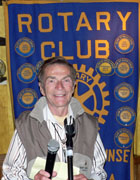Dr Ralph Black, Great Advances in Medicine

Our Club member Ralph Black was in medical school at the University of Alberta in Edmonton, Canada, when polio eradication began in North America. When he entered in 1951, polio was still prevalent and everyone was concerned about contracting this paralyzing disease. The hospital wards were filled with Iron Lungs, long horizontal tubes supported on legs with wheels. The paralyzed patients’ bodies were sealed inside these containers with airtight seals at the neck so that only the head was outside. The machines had electric motors pumping air in and out of the tube continuously to pump the patients’ lungs by vacuum effect, and the nurses also had to feed the patients and clean and care for them in these machines.
In 1952, Jonas Salk announced that he had isolated live polio virus and was making a polio vaccine from it. In that year, all of the medical students in Dr Black’s medical school got polio shots for protection, even though the vaccine was still untested. Over the next several years, the incidence of polio in North America dropped dramatically, and by 1954 the respirators had disappeared from hospital wards. By then, the medical schools were no longer teaching their students how to diagnose polio, because it was assumed to be disappearing. Soon, Albert Sabin developed an oral version of polio vaccine, which is still used today. There was controversy in the medical profession for a number of years after that about which version of polio vaccine was most appropriate for which circumstances.
In 1985, HIV virus was noted as a mysterious unknown illness in Los Angeles affecting young males who were getting sick and dying (one of them was the prominent actor Rock Hudson). The Los Angeles County-USC Hospital developed a specialized ward for evaluating and treating these people. Because of the public stigma associated with this devastating disease, a State law was passed mandating total confidentiality for all related diagnostic and treatment services, so that test results could only be reported with a numeric code to identify the patient. Eventually, drugs were developed to stop the multiplication of the virus in the body’s immune cells to provide remission of the infection. In 1992, Dr Black received an accidental needle stick while starting an IV line on an HIV-positive patient; he was immediately given 3 antiviral drugs and was taken off work for one week. Fortunately, he remained HIV-negative. In the past year, only one new medication has been used instead of the previous combination.
Research has been conducted for a number of years to develop artificial blood, in hopes of avoiding contaminated donated blood and the need for blood banks. This is still in the future.
Propofol is a very effective intravenous anesthetic used on millions of surgery patients. Its activity lasts only about 30-60 minutes, so it wears off quickly when it’s time to awaken the patient. It is safe and effective when used appropriately, but its repeated use on the late celebrity Michael Jackson by his cardiologist to treat his insomnia resulted in murder charges against the cardiologist.